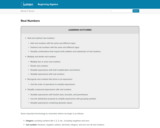
Real Numbers
- Subject:
- Algebra
- Mathematics
- Material Type:
- Lesson Plan
- Student Guide
- Teaching/Learning Strategy
- Provider:
- Lumen Learning
- Date Added:
- 01/12/2021

Real Numbers
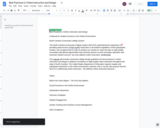
This Google Doc is a brief ideation of best practices in online instruction. As the community contributes more ideas and content, this document will serve as a rough draft for review by this professional learning community.

This is a graphic organizer that depicts the process instructors should use to create, select, or improve instructional graphics, with checklists to assist with planning.

Some students misbehave because they are trying to attract teacher attention. Surprisingly, many students who value adult attention don't really care if it is positive (praise) or negative attention (reprimands)--they just want attention!
Unfortunately, instructors with students who thrive on teacher attention can easily fall into a 'reprimand trap.' The scenario might unfold much like this: First, the student misbehaves. Then the teacher approaches the student and reprimands him or her for misbehaving. Because the student finds the negative teacher attention to be reinforcing, he or she continues to misbehave-and the teacher naturally responds by reprimanding the student more often! An escalating, predictable cycle is established, with the student repeatedly acting-out and teacher reprimanding him or her.
Teachers can break out of this cycle, though, by using 'random positive attention' with students. Essentially, the instructor starts to ignore student attention-seeking behaviors, while at the same time 'randomly' giving the student positive attention. That is, the student receives regular positive teacher attention but at times unconnected to misbehavior. So the student still gets the adult attention that he or she craves. More importantly, the link between student misbehavior and resulting negative teacher attention is broken.
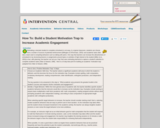
Motivating a reluctant student to complete schoolwork is not easy. In a typical classroom, students can choose from a number of sources of potential reinforcement (Billington & DiTommaso, 2003)--and academic tasks often take a back seat to competing behaviors such as talking with peers. One way that teachers can increase the attractiveness of schoolwork is by structuring lessons or assignments around topics or activities of high interest to the student (Miller et al., 2003).In fact, with planning, the teacher can set up a 'trap' that uses motivating elements to capture a student's attention to complete academic tasks (Alber & Heward, 1996). Here is a 6-step blue-print for building an academic 'motivation trap' (adapted from Alber & Heward, 1996).
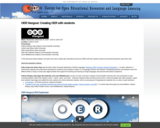
Description provided by COERLL:
COERLL hosted an online “OER hangout” on September 25th on the subject of creating open educational resources (OER) with students. With 26 people attending, five language instructors shared their experiences of working with their students to create openly licensed resources for teaching and learning:
Amber Hoye and Kelly Arispe lead the Boise State University Department of World Languages’ Pathways OER Language Teaching Repository of openly licensed proficiency based activities, created by students and teachers.
Kathryn Murphy-Judy, Ngoc-My Guidarelli, and Laura Middlebrooks are part of a team of faculty at Virginia Commonwealth University who have developed an open, connected platform for students to share authentic resources.
At Boise State, upper-level undergraduate students, with the mentorship of staff and faculty, create activities to be used in the weekly language lab component of introductory language courses. These activities can also be used in the classroom and K-12 teachers in Idaho have been involved in creating and teaching with them. At Virginia Commonwealth University, undergraduate students in the 202 class, who are either majors on their way to upper level courses or students finishing their language requirement, curate authentic resources and discuss them with native speakers. Then, upper level students turn those curations into instructional modules, which are being integrated into online open textbooks.
You can learn more about the logistics of these projects by viewing the webinar video, reading about the projects, and perusing the materials. Here, we’ll mention a few of the important themes that came up during the discussion.
One important element of students being involved in materials creation is that they understand what other students will be interested in and can choose topics and texts they know their peers will enjoy. Involving students ensures that a more diverse array of voices and perspectives are represented in the materials, and gives students more of a choice in their own education. Students also gain skills beyond language and culture when they work on these projects: digital citizenship, open license knowledge, technical skills, an understanding of language proficiency, and knowledge of state and national standards.
Each of these projects has a broad community of people with various skills who can support each other and contribute in different ways. At Boise State, the language resource center director, language students and students from other departments, faculty mentors, SLA & CALL researchers, K-12 teachers, state partners, and librarians have all contributed to the OER. At VCU, students, faculty, and librarians contribute to the materials and partnerships are developing with K-12 teachers who use the materials in their courses.
Each of these projects follows an iterative process of development. The work doesn’t start and finish in the span of a semester, it grows and changes. Students develop materials, native speakers proofread them, teachers teach with them, and the team refines them. The Pathways Project carries a disclaimer that “The activities on the Pathways Project OER Repository were created by upper-division students at Boise State University and serve as a foundation that our community of practice can build upon and refine. While they are polished, we welcome and encourage collaboration from language instructors to help modify grammar, syntax, and content where needed.” The cycle of the projects is such that lower-level students can get involved in the project as learners, but go on to take a more active role in the project as they progress.
The panelists recommend to anyone interested in creating OER with their students that they start small, and reach out to available communities (institution-wide, or online professional networks) for support and sharing. On that note, COERLL’s next OER hangout is on the topic of joining a teacher community. Join us on November 13th!
View the webinar video, links to the repositories, slides from the presenters, and more on the event page of COERLL’s website.
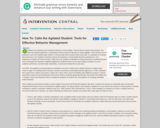
Students can sometimes have emotional outbursts in school settings. This fact will not surprise many teachers, who have had repeated experience in responding to serious classroom episodes of student agitation. Such outbursts can be attributed in part to the relatively high incidence of mental health issues among children and youth. It is estimated, for example, that at least one in five students in American schools will experience a mental health disorder by adolescence (U.S. Department of Health and Human Services, 1999). But even students not identified as having behavioral or emotional disorders may occasionally have episodes of agitation triggered by situational factors such as peer bullying, frustration over poor academic performance, stressful family relationships, or perceived mistreatment by educators.
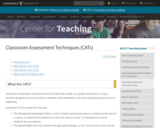
An overview of Classroom Assessment Techniques. The foundational text is: Classroom Assessment Techniques: A Handbook for College Teachers, 2nd edition, by Thomas A. Angelo and K. Patricia Cross (Jossey-Bass, 1993)

This online textbook addresses the population of individuals with disabilities that experience complex lifelong needs across multiple areas in their lives. Drs. Sennott and Loman drafted this book (along with the help from some friends) with the hope of providing pertinent, practical, and current resources to future special educators who plan to serve individuals with complex disabilities.
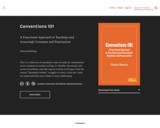
This is a collection of cumulative units of study for conventional errors common in student writing. It's flexible, functional, and zeroes in problems typically seen in writing of all types, from the eternal "there/they're/their" struggle to correct colon use. Units are organized from most simple to most challenging.
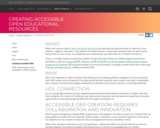
This page provides information about Best Practices and Resources for creating accessible OERs.
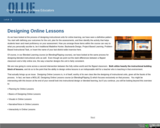
Video about designing online lessons.

Practical tips and techniques for ensuring educational materials follow the POUR principles of accessible design.
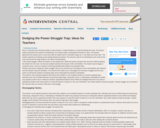
he teacher's most important objective when faced with a defiant or non-compliant student is to remain outwardly calm. Educators who react to defiant behavior by becoming visibly angry, raising their voices, or attempting to intimidate the student may actually succeed only in making the student's oppositional behavior worse! While the strategies listed here may calm an oppositional student, their main purpose is to help the teacher to keep his or her cool. Remember: any conflict requires at least two people. A power struggle can be avoided if the instructor does not choose to take part in that struggle.

Overview of the EQuIP Rubrics for Math and ELA

Looking for engaging content for your economics courses? The Institute for Humane Studies has curated this collection of educational resources to help economics professors enrich their curriculum. Find videos, interactive games, reading lists, and more on everything from opportunity costs to trade policy. This collection is updated frequently with new content, so watch this space!

Thi graphic tutorial will provide instructors with assistance in creating, selecting, or improving instructional graphics, with checklists to assist with planning.
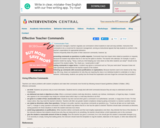
As classroom managers, teachers regularly use commands to direct students to start and stop activities. Instructors find commands to be a crucial tool for classroom management, serving as instructional signals that help students to conform to the teacher's expectations for appropriate behaviors.
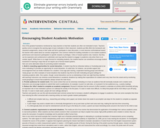
One of the greatest frustrations mentioned by many teachers is that their students are often not motivated to learn. Teachers quickly come to recognize the warning signs of poor motivation in their classroom: students put little effort into homework and classwork assignments, slump in their seats and fail to participate in class discussion, or even become confrontational toward the teacher when asked about an overdue assignment. One common method for building motivation is to tie student academic performance and classroom participation to specific rewards or privileges. Critics of reward systems note, however, that they can be expensive and cumbersome to administer and may lead the student to engage in academics only when there is an outside 'payoff.' While there is no magic formula for motivating students, the creative teacher can sometimes encourage student investment in learning in ways that do not require use of formal reward systems.
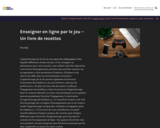
L’apprentissage par le jeu préconise des activités centrées sur les apprenants leur permettant d’explorer, d’échouer et de relever des défis dans un environnement sécuritaire. Il permet également de favoriser l’autonomie des étudiants au sein d’univers créés par les professeurs. De plus, les jeux sont de nature à renforcer l’engagement des étudiants dans le processus d’apprentissage. Dans le contexte éducatif, ces traits caractéristiques et ses qualités peuvent grandement favoriser l’engagement, la motivation et l’apprentissage des étudiants. Un panel interdisciplinaire d’experts propose des recettes pour intégrer différents types d’activités d’apprentissage par le jeu dans le contexte de l’enseignement en ligne. Une gamme d’activités vous sera proposée : du quiz jusqu’aux jeux d’évasion en passant par les jeux coopératifs ou encore les mots-croisés.